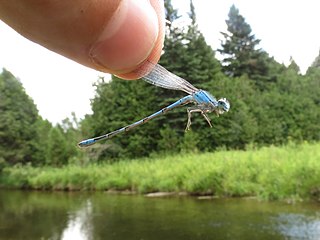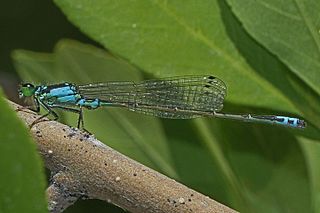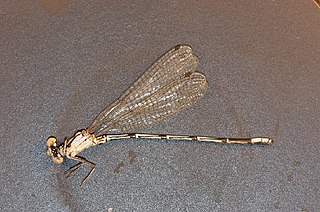
Nehalennia pallidula, the Everglades sprite, is a species of damselfly in the family Coenagrionidae. It is endemic to the United States, where it has been found only in Florida and Texas. Its natural habitats are swamps and freshwater marshes. It is threatened by habitat loss from water diversion, peat fires, and invasive species. It has a low level of detection due to its preference for dense vegetation and its small size.

Nehalennia is a genus of very small damselflies in the family Coenagrionidae. Most of the species are commonly known as Sprites. One species, N. speciosa occurs in Eurasia; the rest in North and South America.

Vestalis gracilis, is a species of damselfly belonging to the family Calopterygidae. It is known commonly as the clear-winged forest glory or clear-winged flash-wing. It is native to Southeast Asia and surrounding regions.

Vestalis apicalis, or the black-tipped forest glory, is a species of damselfly belonging to the family Calopterygidae. It is found in India and Sri Lanka.

Indolestes gracilis is a species of damselfly in the family Lestidae. It is known only from Sri Lanka, South India and Cambodia.

Nehalennia integricollis, the southern sprite, is a species of narrow-winged damselfly in the family Coenagrionidae. It is found in North America.
Argia tarascana, the Tarascan dancer, is a species of narrow-winged damselfly in the family Coenagrionidae. It is found in Central America and North America.

Enallagma anna, the river bluet, is a species of narrow-winged damselfly in the family Coenagrionidae. It is found in North America.

Enallagma laterale, the New England bluet, is a species of narrow-winged damselfly in the family Coenagrionidae. It is found in North America.
Enallagma sulcatum, the golden bluet, is a species of narrow-winged damselfly in the family Coenagrionidae. It is found in North America.

Enallagma durum, the big bluet, is a species of narrow-winged damselfly in the family Coenagrionidae. It is found in Central America and North America.

Somatochlora provocans, the treetop emerald, is a species of emerald dragonfly in the family Corduliidae. It is found in North America.

Erpetogomphus eutainia, the blue-faced ringtail, is a species of clubtail in the family of dragonflies known as Gomphidae. It is found in Central America and North America.

Ischnura damula, the plains forktail, is a species of narrow-winged damselfly in the family Coenagrionidae. It is found in North America.

Enallagma vesperum, the vesper bluet, is a species of narrow-winged damselfly in the family Coenagrionidae. It is found in North America.

Enallagma clausum, the alkali bluet, is a species of narrow-winged damselfly in the family Coenagrionidae. It is found in North America.

Argia alberta, the Paiute dancer, is a species of narrow-winged damselfly in the family Coenagrionidae. It is found in North America.

Argia vivida, the vivid dancer, is a species of narrow-winged damselfly in the family Coenagrionidae. It is found in Central America and North America. It is the state insect of Nevada.

Argia barretti, the Comanche dancer, is a species of narrow-winged damselfly in the family Coenagrionidae. It is found in Central America and North America.

Enallagma daeckii, the attenuated bluet, is a species of narrow-winged damselfly in the family Coenagrionidae. It is found in North America.



















